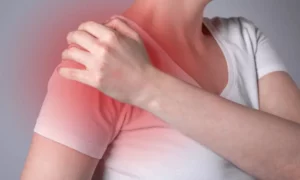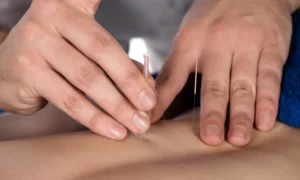Perimenopause, the transitional phase before menopause, brings about various changes in a woman’s body. Among these changes, joint pain emerges as a common and often perplexing symptom. Understanding the causes, symptoms, and effective treatments for joint pain during perimenopause is crucial for women navigating this phase of life. In this article, we will talk about joint pain perimenopause treatment options, alternate therapies and much more.
Contents
- 1 What Causes Joint Pain During Perimenopause?
- 2 Symptoms Of Joint Pain In Perimenopause
- 3 Treatment Approaches For Joint Pain In Perimenopause
- 3.1 Hormone Replacement Therapy (HRT)
- 3.2 Pain Medications
- 3.3 Physical Therapy
- 3.4 Lifestyle Modifications
- 3.5 Exercise and Stretching
- 3.6 Weight Management
- 3.7 Hot and Cold Therapies
- 3.8 Joint Protection Techniques
- 3.9 Stress Management
- 3.10 Topical Analgesics
- 3.11 Dietary Supplements
- 3.12 Alternative Therapies
- 4 Alternative Therapy Options For Joint Pain In Perimenopause
- 5 Prevention Strategies
- 6 Conclusion
What Causes Joint Pain During Perimenopause? 
Joint pain during perimenopause, the transitional stage leading to menopause, can be attributed to various factors related to hormonal changes and aging. Here are some potential causes of joint pain in perimenopause:
- Hormonal Fluctuations
Estrogen plays a role in maintaining joint health by influencing the production of collagen and synovial fluid. The decrease in estrogen during perimenopause can lead to changes in joint structure and function, contributing to pain and stiffness.
- Inflammation
Hormonal fluctuations can trigger inflammation in the body which may affect joints and contribute to pain. Chronic inflammation can exacerbate pre-existing joint conditions or lead to new issues.
- Bone Density Changes
During perimenopause and menopause, women may experience a decline in bone density due to reduced estrogen levels. This can increase the risk of osteoporosis, making joints more susceptible to pain and fractures.
- Muscle Mass Changes
Hormonal changes can also impact muscle mass and strength. Weakened muscles may fail to adequately support and stabilize joints, leading to increased stress on the joints and pain.
- Weight Gain
Many women experience weight gain during perimenopause, which can place additional stress on joints, especially in weight-bearing areas like the knees and hips. This added pressure can contribute to joint pain.
- Autoimmune Disorders
Perimenopausal women may be at an increased risk of developing autoimmune conditions like rheumatoid arthritis. This can result in inflammation and pain in the joints.
- Genetic Predisposition
Genetic factors can influence an individual’s susceptibility to joint problems. If there is a family history of arthritis or other joint conditions, there may be an increased risk.
- Nutritional Deficiencies
Inadequate levels of vitamin D and calcium, essential for bone health, can contribute to joint pain and stiffness.
It’s important to note that individual experiences may vary, and joint pain during perimenopause can be influenced by a combination of these factors.
Symptoms Of Joint Pain In Perimenopause
In perimenopause, joint pain can manifest with various symptoms that may impact a woman’s daily life. It’s important to note that not everyone will experience the same symptoms, and the severity can vary. Common symptoms of joint pain during perimenopause include:
- Pain and Discomfort
Women may experience pain in one or multiple joints. The pain can range from mild to severe and may be described as aching, throbbing, or sharp. - Stiffness
Joints may feel stiff, especially after periods of inactivity or upon waking in the morning. Stiffness can affect mobility and flexibility. - Swelling
Some individuals may notice swelling around the affected joints. This can be a result of inflammation in the joint tissues. - Reduced Range of Motion
Joint pain can lead to a decreased range of motion, making it challenging to perform certain movements or activities. - Warmth and Redness
Inflammation in the joints can cause them to feel warm to the touch and appear red. This is particularly common in cases of inflammatory joint conditions. - Fatigue
Chronic joint pain and discomfort can contribute to overall fatigue and a sense of low energy. - Joint Crepitus
Some women may experience joint crepitus, which is a crackling or popping sound when moving certain joints. This can be associated with changes in joint surfaces. - Difficulty Sleeping
Joint pain can interfere with sleep, leading to difficulties falling asleep or staying asleep throughout the night. - Tenderness
Joints may be tender to the touch, and pressure on the affected areas can elicit pain. - Morning Joint Stiffness
Many women with perimenopausal joint pain report increased stiffness in the morning, which tends to improve with movement as the day progresses. - Impaired Function
Joint pain can impact daily activities, such as walking, climbing stairs, or performing routine household tasks. It may affect the overall quality of life.
Treatment Approaches For Joint Pain In Perimenopause 
The treatment of joint pain during perimenopause involves a comprehensive approach aimed at addressing the underlying causes, managing symptoms, and improving overall joint health. Here are various treatment approaches that may be considered:
Hormone Replacement Therapy (HRT)
For some women, hormone replacement therapy (HRT) may be recommended to address hormonal imbalances, particularly the decline in estrogen. This can help alleviate joint pain and other symptoms associated with perimenopause.
Pain Medications
Over-the-counter nonsteroidal anti-inflammatory drugs (NSAIDs), such as ibuprofen or naproxen, can help reduce pain and inflammation. In some cases, prescription medications may be considered.
Physical Therapy
A physical therapist can develop a tailored exercise program to improve joint flexibility, strength, and overall function. This can help manage pain and prevent further joint deterioration.
Lifestyle Modifications
Adopting a healthy lifestyle can contribute to joint health. This includes maintaining a balanced diet, managing weight, staying physically active, and avoiding excessive alcohol consumption.
Exercise and Stretching
Engaging in regular, low-impact exercises like swimming, walking, or cycling can help improve joint flexibility and reduce pain. Stretching exercises can also be beneficial for maintaining a joint range of motion.
Weight Management
Maintaining a healthy weight is crucial, as excess weight can contribute to increased stress on weight-bearing joints. A balanced diet and regular exercise can aid in weight management.
Hot and Cold Therapies
Applying heat or cold to affected joints can provide relief. Warm compresses or heating pads may help relax muscles and soothe joint pain, while cold packs can reduce inflammation.
Joint Protection Techniques
Learning proper joint protection techniques, such as using assistive devices, wearing supportive footwear, and avoiding repetitive stress on joints, can help manage pain and prevent further damage.
Stress Management
Stress can exacerbate symptoms of joint pain. Practices such as yoga, meditation, and deep breathing exercises can help manage stress and improve overall well-being.
Topical Analgesics
Topical creams or patches containing analgesic ingredients, such as menthol or NSAIDs, can be applied directly to the skin over the affected joints to provide localized relief.
Dietary Supplements
Some individuals may benefit from dietary supplements such as glucosamine and chondroitin, which are believed to support joint health. However, it’s important to consult with a healthcare professional before using supplements.
Alternative Therapies
Acupuncture, massage therapy, and chiropractic care are alternative therapies that some individuals find helpful for managing joint pain. Consult with a healthcare provider before trying these approaches.
Individualized treatment plans may vary based on the severity of symptoms, underlying health conditions, and individual preferences. It’s crucial for individuals experiencing joint pain during perimenopause to consult with a healthcare professional for a thorough evaluation and personalized guidance.
Alternative Therapy Options For Joint Pain In Perimenopause 
Several alternative therapies may be considered for managing joint pain during perimenopause. While individual responses to these therapies vary, some women find relief through the following approaches:
- Acupuncture
Acupuncture involves the insertion of thin needles into specific points of the body. Some women report reduced joint pain and improved mobility after acupuncture sessions.
- Massage Therapy
Massage can help alleviate muscle tension and promote relaxation. Specific techniques may be used to target areas of joint pain, providing relief and improving overall well-being.
- Chiropractic Care
Chiropractors use spinal adjustments and other manual techniques to address joint misalignments. This can sometimes contribute to pain relief and improved joint function.
- Herbal Remedies
Certain herbs, such as turmeric, ginger, and Boswellia, are believed to have anti-inflammatory properties. These herbs may be taken as supplements or incorporated into the diet to potentially reduce joint inflammation.
- Omega-3 Fatty Acids
Fish oil supplements, rich in omega-3 fatty acids, may have anti-inflammatory effects. They are known to support joint health and can be considered as part of a holistic approach.
- Mind-Body Practices
Practices like yoga and tai chi emphasize gentle movements, stretching, and relaxation techniques. These activities can improve flexibility, balance, and overall joint function.
- Cognitive Behavioral Therapy (CBT)
CBT is a form of psychotherapy that focuses on changing negative thought patterns and behaviours. It may help individuals cope with the emotional aspects of living with chronic pain.
- Aromatherapy
Essential oils, such as lavender or peppermint, may be used in aromatherapy to promote relaxation and reduce stress, potentially contributing to pain relief.
- Homeopathy
Some women explore homeopathic remedies for joint pain. Consultation with a qualified homeopathic practitioner is recommended for personalized recommendations.
Prevention Strategies
- Early Interventions
Proactive measures, including lifestyle adjustments and early medical interventions, can prevent or minimize perimenopausal joint pain. - Healthy Lifestyle Choices
Maintaining a healthy lifestyle, including regular exercise and a balanced diet, is crucial for joint health. - Regular Check-ups
Routine medical check-ups can help identify and address joint issues before they become more severe.
Conclusion
In conclusion, understanding and managing joint pain during perimenopause is a multifaceted journey. With a combination of traditional treatments, natural remedies, lifestyle adjustments, and expert guidance, women can navigate this phase with greater ease. It’s crucial to seek support, share experiences, and stay informed for a holistic approach to perimenopausal joint pain.
If you are facing menopause related issues, menopause treatment at HerMantra can help. Book your free trial online menopause treatment session now.





